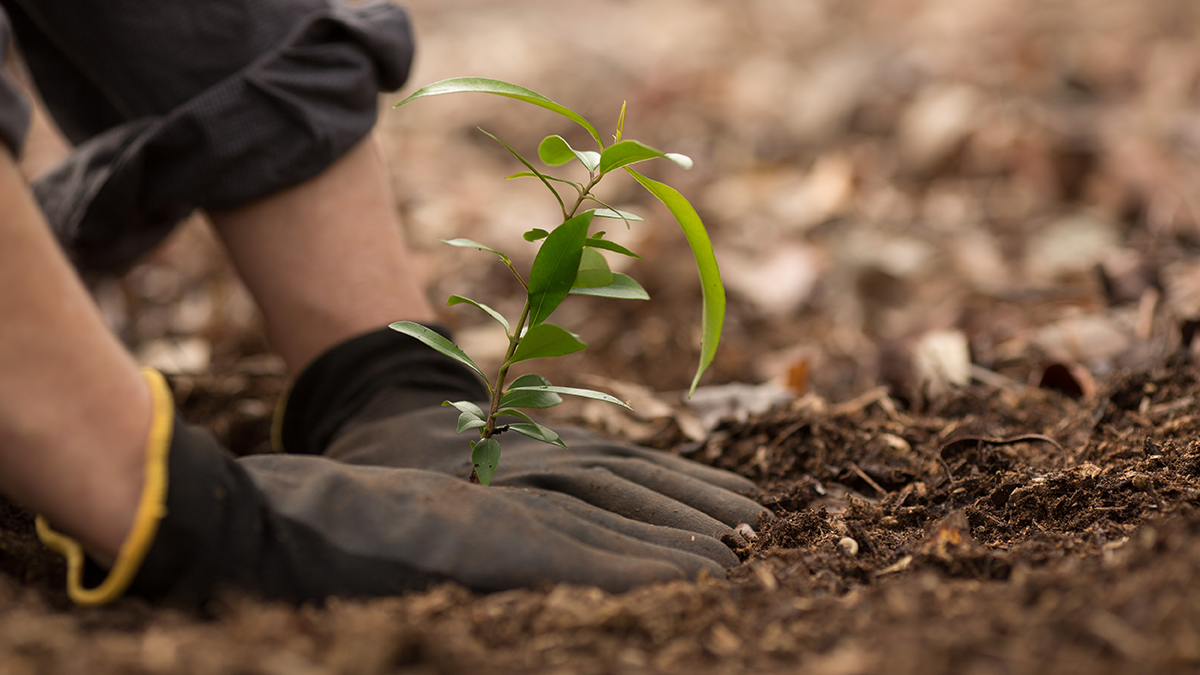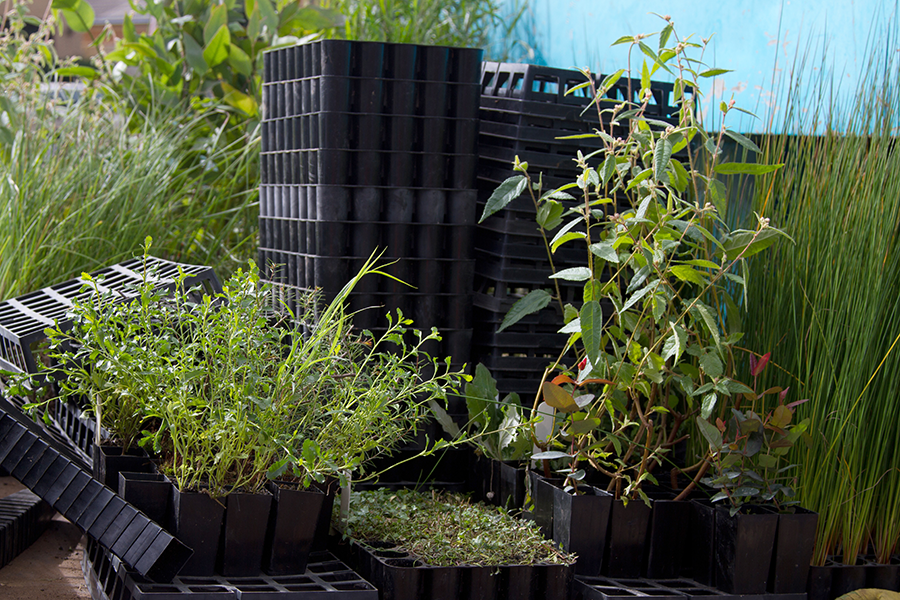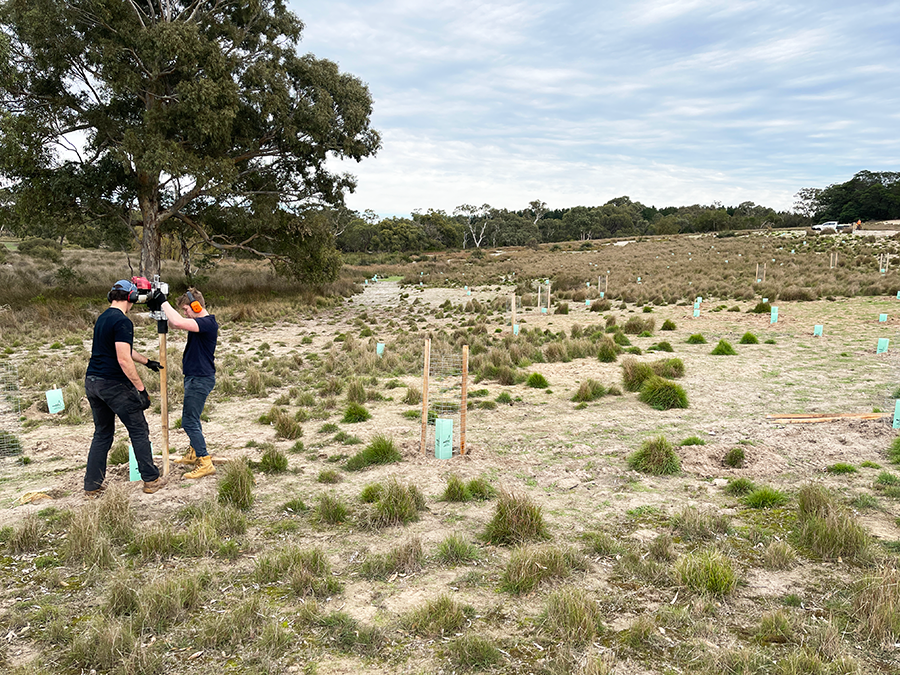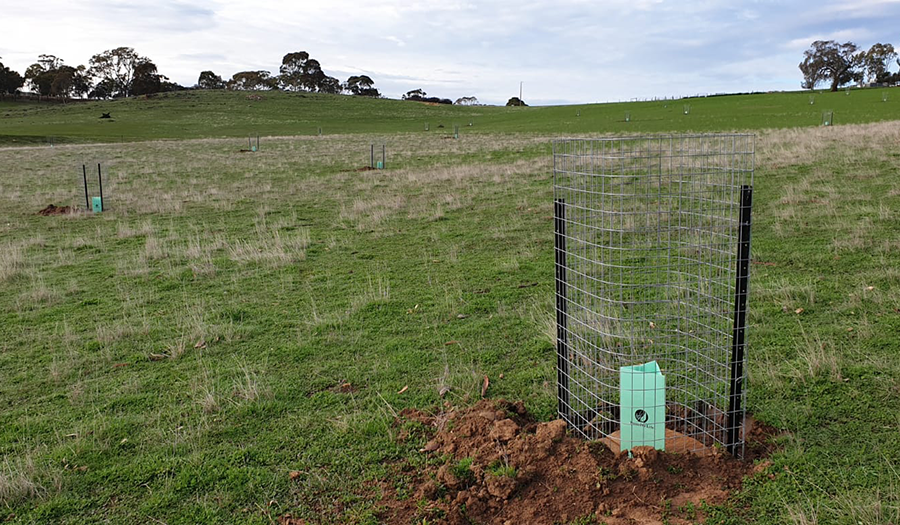Planting and seeding: From small things, big things grow

You've finally arrived at the exciting part of your project. You've identified your Major Vegetation Group (MVG), selected the species of plants that best represent the vegetation association you are trying to recreate, completed your weed control, and you're now ready to start getting some plants in the ground. This is where you begin to see big things growing from tiny little seeds!1.
Methodologies
The two most commonly used methods to revegetate a site are:
- Planting pre-grown tubestock, or
- Direct seeding into the soil.
Both methods are done via machine or by hand. Some revegetation projects, such as a paddock tree planting project, may require a small number of advanced trees. Advanced trees are also planted with machine help or by hand.
Often a site will benefit from a variety of planting methods. Perhaps you have a riparian site with a steep, loamy bank leading to a flat, sandy paddock. You may wish to use vehicle-driven direct seeding machines for the flat paddock and a mix of hand niche seeding and tubestock along the steep bank.
Planting Tubestock
When it comes to planting tubestock, there are several different tools used for hand planting. These include the Pottiputki, the Hamilton planter, planting spades, or even petrol-powered augers. Machines are available for large scale tubestock planting. However, these do require flat to gently undulating country.
Seedlings must be well watered before being planted and placed in the ground. Make sure there are no air gaps between the root ball and the surrounding soil. Ensure the root ball is completely covered with soil and the area tamped down firmly. A shallow dish can be helpful to direct water into the seedling.
The table below provides a brief outline of some of the advantages and disadvantages of seedling planting methods.
| Seedling Planting Method | Advantages | Disadvantages |
| Machine planting | Suited to large-scale revegetation establishment on flat to gently undulating country. Can achieve high volume seedling planting. Well suited to planting requiring consistent spacing and rows of trees (e.g., shelterbelts or woodlots). Very little operator fatigue. |
Not suited to projects that require inconsistent, ‘natural’ spacing of plants. Generally, requires significant soil preparation beforehand. Unsuitable for steep, rocky or vehicle inaccessible sites. |
| Petrol auger/machine auger planting |
Creates a planting hole quickly. Can form a basin/bowl for holding water. |
Can leave smooth sides to hole walls which promotes root wrapping/binding if an inappropriate auger bit is used. |
| Pottiputki planting | Suitable for all site types. Using this system, more than 2,000 seedlings/person/day can be planted (up to 6,000 seedlings/person/day in some woodlot situations). Able to be done with the operator standing up, reduces fatigue. Pottiputki is available in a variety of sizes to suit seedling root mass size. Can be used to apply fertiliser tablets. |
Expensive to purchase. Requires separate tools for different plant sizes. |
| Hamilton planting | Suitable for all site types. Available in sizes to suit common cell grown seedlings, so creates a planting hole exactly the right size for seedling root mass. Can be used to apply fertiliser tablets. Simple design and construction make them reliable. |
Have to bend down to plant seedling. Requires separate tools for different plant sizes. |
| Planting spade |
Simple design and construction make them reliable. Great for school and community planting projects. Forestry contractors can plant upwards of 6,000 seedlings/person/day using these spades. |
Generally requires soil preparation beforehand. |

Image: Tubestock native trees ready for revegetation planting.
Direct Seeding
Direct seeding can be completed with machines or by hand, with the site type and planting design dictating what seeding method you use. Seeds are put in individual spots using a technique called niche seeding. You can broadcast the seed with spreaders, or the seeds can be put into the ground using various machines designed for this purpose.
Generally, direct seeding is a cheaper option for getting a more significant number of plants on the site than planting seedlings. However, it comes with the disadvantages of having less control over individual species locations, and it is not suited to all species. The timing of the seeding is also far more critical than that of planting seedlings.
With some species, treat the seeds before they're seeded. For example, 'hard' seeds such as Acacia, Dodonaea or Hardenbergia seeds benefit from hot water treatment, whereas species like Callitris seed benefit from a 'cold snap' in a freezer before being sown. Scarification or smoke treatment is also helpful for some species.
Careful attention needs to be paid to the proportion of different seed mixes in a direct seeding application, as not every species will have the same germination rate. A careless application could mean you end up with one particular species dominating the rest, resulting in an overcrowding problem. Alternatively, there may not be sufficient seed to ensure good site coverage if you're dealing with a species that does not grow well. Here are some native seed suppliers.
The table below provides a brief outline of some of the advantages and disadvantages of direct seeding methods.
| Seeding Method | Advantages | Disadvantages |
| Machine direct seeding |
Efficient for large areas. Variety of machines available to suit different soil types. Some machines include weed control and soil preparation in the seeding process. Hydroseeding also holds the soil together whilst the seed germinates. |
Germination rates can be inconsistent. Can only access sites suitable for vehicles. Some machines may require soil preparation beforehand. |
| Niche seeding/rake hoe | Consistent seed distribution. The seeding process is also the soil preparation process. More control over seed depth in the soil. Able to be used on all site topographies. |
Labour intensive, so better suited to smaller projects. Germination rates can be inconsistent. |
| Hand broadcast seeding |
Easy to apply. Multiple seed types can be spread in one pass. Low cost to apply compared to seedling planting. |
Requires soil preparation beforehand. Can result in inconsistent seed distribution. Leaves seed above ground level unless cultivated afterwards. Germination rates can be inconsistent. |
| Spinner broadcast seeding |
Easy to apply. Consistent seed distribution. Low cost to apply compared to seedling planting. |
Requires soil preparation beforehand. Separate passes are needed for different seed types. Leaves seed above ground level unless cultivated afterwards. Germination rates can be inconsistent. |
Timing
Plants require warmth and moisture to grow, and planting timeframes need to be planned around these two things being available. As a general rule, cold, wet winters do not have the warmth required for plant growth and hot, dry summers do not have the moisture necessary for plant survival. Seasonal weather conditions vary from State to State, each having different wet and dry seasons, and weather varies from site to site within each State.
If you're aiming for a spring planting in a part of Australia with a hot, dry summer, wait until the soil temperatures increase, and the risk of frost has passed. But ensure sufficient moisture is still present in the soil. The lower the rainfall, the earlier planting can begin. Low rainfall, semi-arid areas achieve a higher survival rate when planted in late winter. In higher rainfall areas or extremely damp riparian sites, a later spring planting may be beneficial. But don't leave it too late, or the seedlings won't have their roots down before it gets too hot!
If an autumn planting in the same climate is your goal, wait until the opening rains have dampened the ground sufficiently for the plants' survival. The benefit of a correctly timed autumn planting is that the plants can have their roots down and established before the winter rains and will be in a position to burst out in new growth in spring. This is especially helpful in drier sites as it increases survival chances significantly.
Occasionally a winter planting in a very dry site is even desirable. Higher rainfall sites may struggle with a late autumn planting, as sodden conditions can make it difficult for the plants to survive the first winter.

Image: Late Autumn tree planting on a "Cockies for Cockies" revegetation site in Naracoorte, South Australia. Copyright Arborgreen.
Planting in a wet or dry tropic area will have a completely different schedule but is based on the same principles of warmth and moisture being available. Dry periods of two to three weeks often occur early in the wet season and can reduce the survival of seedlings, so delay planting until there is consistent rainfall. Planting around early January is usually a good time, but the critical factor on all sites is monitoring the season and adapting planting times accordingly.
As with weed control, there is no 'one size fits all' when it comes to your planting, especially considering there are a vast array of different climates and rainfall conditions within Australia. Soils For Life is an excellent resource for State-specific conservation and revegetation programs, which can help with advice on planting and seeding.
Next steps
In our next post, we look at fertilisers and whether or not you need them in your native revegetation project.
If you have any questions relating to the two planting methods and which is one best suited for your revegetation project, feel free to reach out to our team. Please email us at info@arborgreen.com.au.
If you've recently completed a noteworthy tree planting or bush revegetation project and you would like to feature your planting project, follow this link to fill in your project details.
Access the full Revegetation blog series.
References
1The planting or seeding techniques you'll use will have been determined during the planning stage of your project. In this post, we break these techniques down in more detail.
/Arborgreen%20-%20DGreen%20-%20RGB%20-%20Sml.png?width=1045&height=347&name=Arborgreen%20-%20DGreen%20-%20RGB%20-%20Sml.png)

